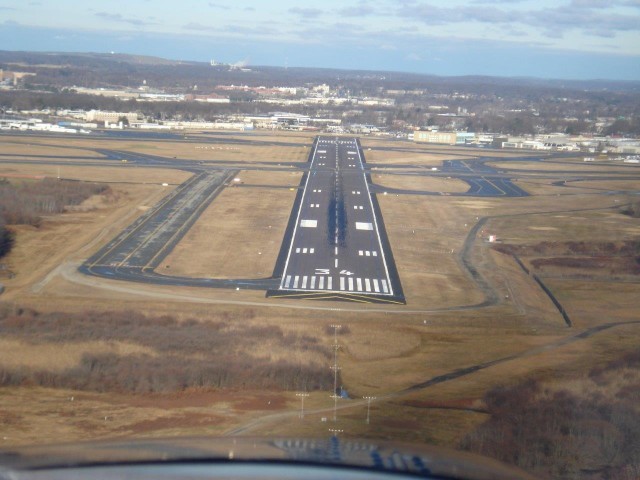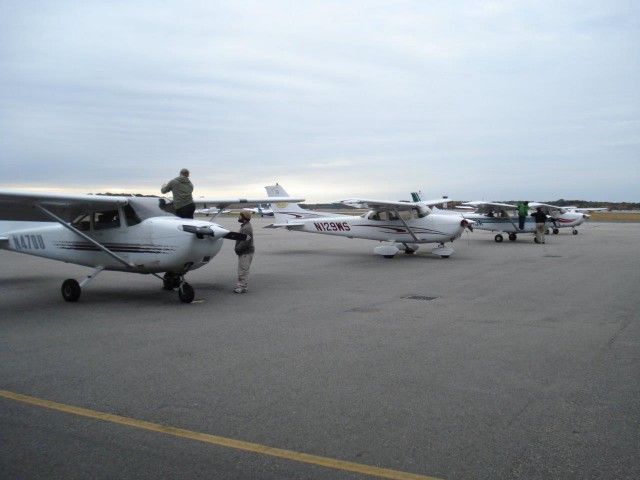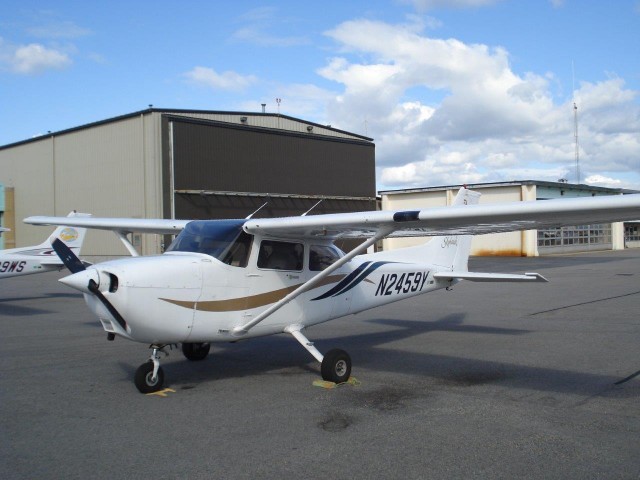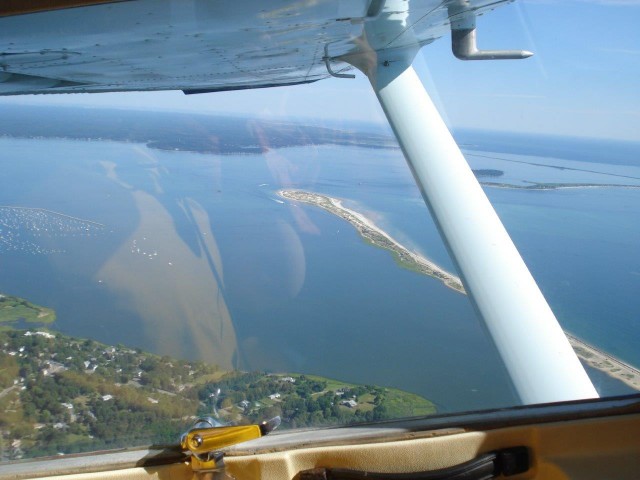Lunchtime ’“ I arrive at Airport Road in Warwick, having driven past the usual airport entrance and around the end of the field. There are hangars behind the fence, a big ’œLearn to Fly Here’ sign on the end of the large hangar. A trail of little yellow airplanes painted on the sidewalk leads to the school door in the old control tower building. I go through the door. A counter ’“ I’m immediately greeted by a young guy whose name badge said Chris. There are aviation prints, flags from around the world from people who learned at the school, a case with headsets and aircraft models, some seats, and magazines.
We do some paperwork. Chris detects my Scottish accent. He will need to perform a background check on me before I am ever able to solo. A legacy from 9/11. I explain I’m actually an American and produce a US Passport. Clearly this has just saved a ton of extra paperwork. Big smile from Chris. We talk about – what else – flying. My instructor is finishing up with the last student ’“ he will be right with me.
Someone appears through a door telling the person who is clearly a student what they will do next time. I’m introduced to Greg. He snags me a guest headset from the school’s loaner pile, grabs a flight box for an aircraft, and takes me down to the classrooms on the side of the hangar. Each desk has a computer, books, and some aviation print or similar. We sit down at his and go over what is about to happen. We are cautiously sounding each other out. We turn to the computer and get a volume of information from it (don’t worry, it gets easier with time) weather, standard briefing, radar picture, METARS, TAF’s, TFR’s and NOTAMS all written in code and requiring interpretation. I note the website we are using for later study. We do this before EVERY flight. Especially TFR’s ’“ Temporary Flight Restrictions ’“ they can pop up at a moment’s notice and leave you grounded or in big trouble if you fly.
We go out to the aircraft. Cessna 172s and 152s ’“ they are all parked in a neat row with their nose wheels over one of those little yellow painted aircraft symbols. We go up to N2459Y, a Cessna 172. Greg produces a checklist and we give the aircraft a thorough pre-flight inspection. This cannot be rushed or compromised, and it uses up a portion of the lesson while you understand the importance and implications of everything you check over. We get in ’“ Greg putting me in the left (pilot’s) seat. I picked the larger and slightly more expensive 172 aircraft for comfort. Let’s just say you had better not mind being close buddies in the cramped, smaller 152.
More checklists ’“ getting ready ’“ more checklists ’“ starting up ’“ Greg’s hands are a blur on the radio panel ’“ switching and setting and GPS programming and VOR settings and clicking and ’œcheck check’ in my ears to make sure I hear him. We taxi over to the run-up pad ’“ Greg driving from the right seat. Swing into the wind to keep the engine cool and another checklist. Runup, dials and needles checked, switches pulled and flicked. I’m prompted into performing some of the actions because I can reach the switches more easily from my seat. Radio calls for clearance.
My familiarity with the phonetic alphabet from a past life at sea and an understanding of how runways are marked means about 10% of the chatter is intelligible. Otherwise I would be lost. Apparently we are cleared to taxi. We start moving and Greg suggests I might like to try steering, with my feet, on the rudder pedals. I’m hardly capable of staying on the yellow line all the way to the taxiway. I keep instinctively trying to steer with the yoke in front of me, like a car wheel, and it does exactly squat for my heading. I’m told I will get it in time.
We arrive at a runway. More checklists, radio chatter, and switch flicking. I think I heard we were cleared to take off. We pull onto the runway and I’m told to try flying her off ’“ he is kidding, right? Full power, keep her in the middle ’“ when that needle gets to 55, pull back gently. He has a set of controls too and he is clearly shadowing me, but off we go and amazingly I seem to get her into the air. We turn ’“ that way ’“ I’m looking at the Directional Gyro, like a ship’s compass. I can do this bit and I point in the right direction as we climb out. ’œNo no ’“ stop looking at the instruments ’“ only for a moment ’“ look at the horizon ’“ look outside ’“ see how the plane makes an angle with the sky?’ Another flurry of radio activity, switch flicking, and we climb out to the Newport Training Area. We level off and fly along. Another checklist.
We do some simple turns and climbs and descents. I’m told not bad. A lot of emphasis is placed on ’œYour controls’, ’œMy controls’, ’œYou have the controls.’ There is going to be no doubt or ambiguity as to who is flying the plane! We perform clearing turns, try slow flight with flaps and perform a stall or two. ’œIt is just another maneuver ’“ not fatal.’ I know in my mind that there is a qualifier to that. You need to be high enough to get out of it, but we started at 3,000 feet and only seem to lose a couple of hundred feet. Looking around, I can see we are being blown across the sky by the wind. This is like ferry gliding in a tide. The visual cues are all the same.
Time to head back. We are cleared for runway 34 and I can see it and relate to it on the Directional Gyro, which we correct because it precesses. This is the first thing of the day that I have ’œgot’ and which I can relate to. Everything else; all preconceived notions have been blown out the window. I even understand we are being blown across our heading slightly and start correcting with a crab angle so we proceed directly to it. Now I just do as I am told ’“ pulling out power, pointing the nose down, adding flaps, pointing the nose down at what seems a truly disastrous angle that must lead to an impact with the runway. We are bucketing around a bit in the turbulence and suddenly Greg’s hands are a blur on the yoke as he corrects for the gusts in the last few feet and I pull my feet away from the rudder pedals as he dances on them too. We are down. More radios, switch flicking, and we pull off the runway. I try taxiing back to the school. I’m not much better, lurching and wobbling along and missing the yellow line I am supposed to be following about 80% of the time.
Greg takes her back and by looking at some indeterminate marker ’“ I have no idea what he is actually looking at ’“ he parks her. When we get out, the nosewheel is bang on the little yellow airplane. We run through some more checklists to secure the aircraft. I manage to put in the wheel chocks without making a klutz of myself.
Back into the classroom. What do I think? Do I want to try this? Do I want to buy the lesson pack now or wait till I have had another couple of lessons and then make my mind up? I buy the pack on the spot ’“ I get a flight bag with a pile of books, a syllabus, reference material, some very intimidating looking question packs and a plotter, an E6B calculator, and a logbook. We fill in the logbook. On my way out, the manager has a quiet word in my ear. Am I happy with Greg or do I want to try another instructor? There is nothing wrong with Greg, he emphasizes, just that a personality match on such an undertaking is pretty important. I can try flying with others if I want.
Greg has been thoroughly professional, I understood everything he explained, and I felt quite safe. He looks a hair older than the other youngsters I saw in the classroom. I am happy to stick with Greg and say so. I take a copy of the checklists too ’“ looks like I have a lot to learn there.
This was written by Graeme J W Smith for AirlineReporter. Smith was 50 when he decided to do this. 54 now with about 1,010 hours under his belt, Tail and Complex, finishing up his Commercial for fun and IFR for serious and about to go get a seaplane rating. Working on flying the WWII warbirds.




Great story but and insight is airplanes are parked in hangars clothes are hung on hangers.
Graeme fails spelling, Eric fails grammar (but and insight?!) 🙂
What airport is it?